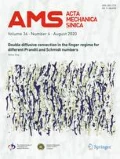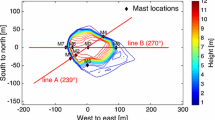Abstract
In the current paper, we have primarily addressed one powerful simulation tool developed during the last decades—Large Eddy Simulation (LES), which is most suitable for unsteady three-dimensional complex turbulent flows in industry and natural environment. The main point in LES is that the large-scale motion is resolved while the small-scale motion is modeled or, in geophysical terminology, parameterized. With a view to devising a subgrid-scale(SGS) model of high quality, we have highlighted analyzing physical aspects in scale interaction and energy transfer such as dissipation, backscatter, local and non-local interaction, anisotropy and resolution requirement. They are the factors responsible for where the advantages and disadvantages in existing SGS models come from. A case study on LES of turbulence in vegetative canopy is presented to illustrate that LES model is more based on physical arguments. Then, varieties of challenging complex turbulent flows in both industry and geophysical fields in the near future are presented. In conclusion, we may say with confidence that new century shall see the flourish in the research of turbulence with the aid of LES combined with other approaches.
Similar content being viewed by others
References
Moin P. Direct and large eddy simulation of turbulence. In: J.L. Lumley et al. eds, Research Trends in Fluid Dynamics, AIP Press, 1996. 188–193
Moin P. Tackling turbulence with supercomputers.Scient Amer, 1997, 276(1): 62–76
Spalart PR. Strategies for turbulence modeling and simulation.Private Communication, 1997
Zhou Y. Advances in the fundamental aspects of turbulence transfer, interacting scales and self-preservation in isotropic decay.Appl Mech Rev, 1998, 51(4): 267–301
Deardorff JW. Convective velocity and temperature scales for the unstable planetary boundary layer and for Rayleigh convection.J Atmos Sci, 1970, 27: 1211–1213
Galperin B, Orszag SA. Large Eddy Simulation of Complex Engineering and Geophysical Flows. Cambridge University Press, 1993
Piomelli U. Large eddy simulation: achievements and challenges. In: Progress in Aerospace Sciences, 1999. 335–362
Su MD, Kang QJ. Large eddy simulation of the turbulence flow around a circular cylinder at subcritical Reynolds number.Acta Mechanica Sinica, 1999, 31 (1): 100–105
Yan H, Su MD. Application of simulated small scale model in turbulent round jet flows.Acta Mechanica Sinica, 2000, 32(5): 513–522
Li JC, Xie ZT. Large eddy simulation for canopy turbulent flows.Acta Mechanica sinica, 1999, 31(5): 406–414
Cui GX, et al. Transportation of passive scalar in inhomogeneous turbulence.Acta Mechanica Sinica, 2000, 16(1): 21–27
Lu XY. Numerical study of an oscillatory turbulent flow over a flat plate.Acta Mechanica Sinica, 1999, 15(1): 8–14
Lu XY, Zhuang LX. Numerical study of natural convection in a vertical slot.Acta Mechanica Sinica, 1999, 15(3): 215–224
Pope SB. Turbulent Flows. London: Cambridge University Press, 2000. 558–640
Meneveau C, Katz J. Scale invariant and turbulence models for large eddy simulation.Ann Rev Fluid Mech, 2000, 32: 1–32
Smagoringsky J. General circulation experiments with the primitive equations, I. The basic experiment.Mon Weather Rev, 1963, 91: 99
Baggett JS, Jimenez J, Kravchenko AG. Resolution requirements in large-eddy simulations of shear flows. Annual Research Briefs, CTR, Stanford University, 1997. 51–66
Gong H, Chen S, He GW. An analysis of subgrid-scale interaction with use of results from direct numerical simulations.Acta Mechanica Sinica, 1999, 15(2): 108–115
Hartel C, Kleiser L. Analysis and modeling of subgrid-scale motions in near-wall turbulence.J Fluid Mechanics, 1998, 356, 327–352
Bardina J, Ferziger JH, Reynolds WC. Improved subgrid model for large eddy simulation. AIAA Paper, 1980. 80–1357
Liu S, Meneveau C, Katz J. On the properties of similarity subgrid-scale models as deduced from measurements in a turbulent jet.J Fluid Mech, 1994, 275: 83–119
Domaradzki JA, Saiki EM. A subgrid-scale model based on the estimation of unsolved scales of turbulence.Phys Fluid, 1997, 9(7): 2148–2164
Kerr RM, Domaradzki JA, Barbier G. Small scale properties of nonlinear interaction and subgrid scale energy transfer in isotropic turbulence.Phys Fluids, 1996, 8: 197
Kraichnan RH. Eddy viscosity in two and three dimensions.J Atmos Sci, 1976, 33: 1521
Domaradzki JA, Liu W, Barbier G. An analysis of subgrid scale interaction in numerically simulated isotropic turbulence.Phys Fluids 1993, 5: 1747
Marion M, Temma R. Nonlinear Galerkin methods.SIAM J, Numer Anal, 1989, 26(5): 1139–1157
Cabot W. Wall models in large eddy simulation of separated flow. 1997. 97–106
Deardorff JW. The numerical study of three-dimensional turbulent channel flow at large Reynolds numbers.J Fluid Mech, 1970, 41: 453–480
Baggett JS. Some modeling requirements for wall models in large eddy simulation. 1997: 123–134
Wang M. Dynamic wall modeling for LES of complex turbulent flows. Annual Research Briefs, CTR, Stanford University, 2000. 241–250
Moeng C-H. A large eddy simulation model for the study of planetary boundary layer turbulence.J Atmos Sci, 1984, 41(13): 2052–2062
Lesieu M, Metais O. New trends in large eddy simulation of turbulence.Ann Rev Fluid Mechanics, 1996, 28: 15–82
Shaw RH, Schumaann U. Large eddy simulation of turbulent flow above and within a forest.Boud Layer Meteo, 1992, 61: 47–64
Shaw RH, et al. Influence of foliar density and thermal stability on profiles of Reynolds stress and turbulence intensity in a deciduous forest.Bound Layer Meteo, 1988, 45: 391–409
Patton EG. Large eddy simulation of turbulent flow within and above a plant canopy. Doctorial dissertation of the University of California, 1997
Gao W, et al. Observation of organized structure in turbulent flow within and above a forest canopy.Bound Layer Meteo, 1989, 47: 349–377
Author information
Authors and Affiliations
Additional information
The NSAF project supported by the NSFC and the Chinese Academy of Engineering Physics (10176032)
Rights and permissions
About this article
Cite this article
Jiachun, L. Large eddy simulation of complex turbulent flows: Physical aspects and research trends. Acta Mech Sinica 17, 289–301 (2001). https://doi.org/10.1007/BF02487457
Received:
Issue Date:
DOI: https://doi.org/10.1007/BF02487457




